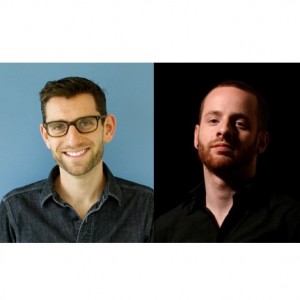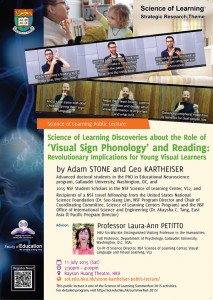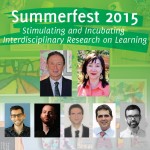Science of Learning Discoveries about the Role of ‘Visual Sign Phonology’ and Reading: Revolutionary Implications for Young Visual Learners

Advanced doctoral students in the PhD in Educational Neuroscience program,
Gallaudet University, Washington, DC, and
2015 NSF Student Scholars in the NSF Science of Learning Center, VL2, and
Recipients of a NSF travel fellowship from the United States National Science Foundation
(Dr. Soo-Siang Lim, NSF Program Director and Chair of Coordinating Committee, Science of Learning Centers Program) and the NSF Office of International Science and Engineering
(Dr. Akaysha C. Tang, East Asia & Pacific Program Director)
Abstract
Decades of research have identified that the capacity to segment the speech stream, called “phonological awareness,” is crucial for acquiring successful reading skills in the very young emergent hearing reader. What happens in the case of deaf children without access to sound? Until recently, it was widely viewed that deaf children without access to spoken language will become poor readers and face academic challenges for life. Here, we present scientific evidence spanning multiple labs in the United States that the brains of profoundly deaf people extract visual sign phonetic-syllabic units from the visual linguistic stream around them, produce these units in infancy, and create a homologous “phonological” level of language organization in the absence of sound (c.f. Petitto & Marentette, 1991; Petitto et al., 2001, 2004; Petitto, 2009) en route to becoming successful readers. Moreover, early sign language-exposed children build upon their visual sign phonology to create connections among orthographic, semantic, and phonological representations, critical for the development of skilled reading, in precisely the same manner as hearing children with sound phonology. We discuss the implications of these findings for the Science of Learning, and how it contributes new knowledge about the role of phonology and its associated neural sites and systems in all human language and reading acquisition. Professor Laura-Ann Petitto, one of the lead researchers in the field on this topic, will serve as the Moderator for this public lecture.
About the speakers
 Adam Stone is a Ph.D. student in the PhD in Educational Neuroscience (PEN) program at Gallaudet University. He is also a NSF Science of Learning Center, Visual Language and Visual Learning (VL2) student scholar and a research assistant in Professor Laura-Ann Petitto’s Brain and Language Laboratory for Neuroimaging (BL2), who is also Stone’s Primary Advisor. Adam has a MA in ASL/English Bilingual Education from the University of California, San Diego and is a former elementary teacher and children’s book author. His primary area of study involves neuroscience investigations of literacy development and bilingual reading in deaf children, and educational technology applications that promote sign language acquisition and literacy in deaf children. Presently, he is pursuing scientific hypotheses about how the human brain builds visual sign phonological representations and how this can afford higher cognitive advantages on young deaf visual learners’ acquisition of English and reading success.
Adam Stone is a Ph.D. student in the PhD in Educational Neuroscience (PEN) program at Gallaudet University. He is also a NSF Science of Learning Center, Visual Language and Visual Learning (VL2) student scholar and a research assistant in Professor Laura-Ann Petitto’s Brain and Language Laboratory for Neuroimaging (BL2), who is also Stone’s Primary Advisor. Adam has a MA in ASL/English Bilingual Education from the University of California, San Diego and is a former elementary teacher and children’s book author. His primary area of study involves neuroscience investigations of literacy development and bilingual reading in deaf children, and educational technology applications that promote sign language acquisition and literacy in deaf children. Presently, he is pursuing scientific hypotheses about how the human brain builds visual sign phonological representations and how this can afford higher cognitive advantages on young deaf visual learners’ acquisition of English and reading success.
 Geo Kartheiser is a Ph.D. student in the PhD in Educational Neuroscience (PEN) program at Gallaudet University. He is also a NSF Science of Learning Center, Visual Language and Visual Learning (VL2) student scholar and a research assistant in Professor Laura-Ann Petitto’s Brain and Language Laboratory for Neuroimaging (BL2), who is also Kartheiser’s Primary Advisor. Kartheiser currently holds the prestigious Ruth L. Kirschstein National Research Service Award Individual Predoctoral Fellowship (F31) from the United States National Institutes of Health. His primary area of interest involves studies of visual attention, brain plasticity, and signed-language assessment tools. Presently, he investigates the limits and boundaries of neural plasticity by examining the brain changes and concomitant cognitive impact that occur when adults learn a new language well after the sensitive periods for human language acquisition have stabilized. Specifically, he is studying how learning a signed language past the sensitive period impacts the neural networks that support language, learning, higher cognition and the processing of visual spatial information. He is further interested in how scientists can improve their dissemination of knowledge in most effective ways with the public.
Geo Kartheiser is a Ph.D. student in the PhD in Educational Neuroscience (PEN) program at Gallaudet University. He is also a NSF Science of Learning Center, Visual Language and Visual Learning (VL2) student scholar and a research assistant in Professor Laura-Ann Petitto’s Brain and Language Laboratory for Neuroimaging (BL2), who is also Kartheiser’s Primary Advisor. Kartheiser currently holds the prestigious Ruth L. Kirschstein National Research Service Award Individual Predoctoral Fellowship (F31) from the United States National Institutes of Health. His primary area of interest involves studies of visual attention, brain plasticity, and signed-language assessment tools. Presently, he investigates the limits and boundaries of neural plasticity by examining the brain changes and concomitant cognitive impact that occur when adults learn a new language well after the sensitive periods for human language acquisition have stabilized. Specifically, he is studying how learning a signed language past the sensitive period impacts the neural networks that support language, learning, higher cognition and the processing of visual spatial information. He is further interested in how scientists can improve their dissemination of knowledge in most effective ways with the public.




